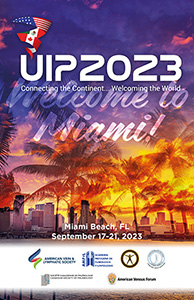Back
Abstracts
Session: Global Abstracts - Monday 10:30 AM
REGISTRY of 185 CONSECUTIVE PATIENTS TREATED with FOAM SCLEROTHERAPY PREPARED with a NEW AUTOMATED MICROFOAM PREPARATION SYSTEM
Monday, September 18, 2023
10:33 AM – 10:43 AM US EDT
Location: Grand Ballroom A
Introduction, Objectives, and/or Purpose: The objective of this study is to present the first registry of patients with varicose veins treated with a new microfoam preparation system.
Methods: A prospective database of patients treated between February 2021 to December 2022. Polidocanol (POL) foam was prepared with a magnetic stirrer with disposable capsules. Foam characteristics (0.18% to 3%): Ratio: from 6.1±0.5 to 6.9±2.6. Radius (microns): from 50.4±6.0 to 67.5±11.3. Half-life time (Tm) (minutes): from 3.4±0.5 to 3.9±1.9. In case of adverse events or patent foramen ovale a low nitrogen mix (O2 (64.6%), CO2 (34%), N2(1.4%)) was used. Foam characteristics: Ratio: from 4.9±0.8 to 5.5±1.8. Radius: from 52.9±5.4 to 69.9±12.9. Tm: from 1.5±0.3. to 1.8±0.3. Volume per session, % of drug, number of sessions, drainage, complications and adverse events were registered. Descriptive statistic was performed.
Results: In 23 months’ period 685 sessions were performed on 185 patients (157 women (84,9%) and 28 men (15,1%)). Median age 51.6 (R: 16-79 yo). Aesthetic veins represents 76.2% of patients and 68.9% of sessions, tributaries and truncal veins 14.1% and 31.9% of patients and 7.2% and 22.6% of sessions respectively. Air foam was used in 173 patients (93.5%) of patients and Low nitrogen foam in 14 (7.5%). 2 patients received both treatments. Average volume per session: aesthetic veins: 8 ml. Great saphenous vein (GSV): 6.9ml. Small saphenous vein(SSV): 4.3 ml. Average drug concentration: Aesthetic veins:0.18%. GSV: 1.49%. SSV:1.63%. Average number of sessions in aesthetic veins: 3.4. Tributaries: 2. GSV:2.7 SSV:2.9. 21 complications were registered (3.1% of sessions / 11.4% of patients), 14 minor complications (2% sessions/ 7.6% patients) and 7 moderate adverse events (1% sessions / 3.8% patients). Minor complications: 10 residual pigmentations (1.5% of sessions, 5,4% of patients), 2 superficial phlebitis (0.3% of sessions, 1,1% of patients), 2 matting (0.3% of sessions,1,1% of patients). 7 Adverse events: visual disturbances 2+1* (0.4% of sessions, 1,6% of patients), neurological symptoms 2+1* (0.4% of sessions, 1.6% of patients) 1 patient presented visual disturbances and neurological symptoms., distal DVT 1 (0.1% of sessions, 0,5% of patients), 1 case of cellulitis (0.1% of sessions, 0,5% of patients).
Conclusion(s): This new device is full versatile to prepare foam with a low rate of adverse events. The low rate of residual pigmentations may be related to the possibility of adjusting the appropriate sclerosant concentration on each case. Further studies are required to continue assessing the impact of this novel and versatile device on the advancement of sclerotherapy.
Methods: A prospective database of patients treated between February 2021 to December 2022. Polidocanol (POL) foam was prepared with a magnetic stirrer with disposable capsules. Foam characteristics (0.18% to 3%): Ratio: from 6.1±0.5 to 6.9±2.6. Radius (microns): from 50.4±6.0 to 67.5±11.3. Half-life time (Tm) (minutes): from 3.4±0.5 to 3.9±1.9. In case of adverse events or patent foramen ovale a low nitrogen mix (O2 (64.6%), CO2 (34%), N2(1.4%)) was used. Foam characteristics: Ratio: from 4.9±0.8 to 5.5±1.8. Radius: from 52.9±5.4 to 69.9±12.9. Tm: from 1.5±0.3. to 1.8±0.3. Volume per session, % of drug, number of sessions, drainage, complications and adverse events were registered. Descriptive statistic was performed.
Results: In 23 months’ period 685 sessions were performed on 185 patients (157 women (84,9%) and 28 men (15,1%)). Median age 51.6 (R: 16-79 yo). Aesthetic veins represents 76.2% of patients and 68.9% of sessions, tributaries and truncal veins 14.1% and 31.9% of patients and 7.2% and 22.6% of sessions respectively. Air foam was used in 173 patients (93.5%) of patients and Low nitrogen foam in 14 (7.5%). 2 patients received both treatments. Average volume per session: aesthetic veins: 8 ml. Great saphenous vein (GSV): 6.9ml. Small saphenous vein(SSV): 4.3 ml. Average drug concentration: Aesthetic veins:0.18%. GSV: 1.49%. SSV:1.63%. Average number of sessions in aesthetic veins: 3.4. Tributaries: 2. GSV:2.7 SSV:2.9. 21 complications were registered (3.1% of sessions / 11.4% of patients), 14 minor complications (2% sessions/ 7.6% patients) and 7 moderate adverse events (1% sessions / 3.8% patients). Minor complications: 10 residual pigmentations (1.5% of sessions, 5,4% of patients), 2 superficial phlebitis (0.3% of sessions, 1,1% of patients), 2 matting (0.3% of sessions,1,1% of patients). 7 Adverse events: visual disturbances 2+1* (0.4% of sessions, 1,6% of patients), neurological symptoms 2+1* (0.4% of sessions, 1.6% of patients) 1 patient presented visual disturbances and neurological symptoms., distal DVT 1 (0.1% of sessions, 0,5% of patients), 1 case of cellulitis (0.1% of sessions, 0,5% of patients).
Conclusion(s): This new device is full versatile to prepare foam with a low rate of adverse events. The low rate of residual pigmentations may be related to the possibility of adjusting the appropriate sclerosant concentration on each case. Further studies are required to continue assessing the impact of this novel and versatile device on the advancement of sclerotherapy.

Enric Roche (he/him/his)
MD PhD
Clinica Vascular Barcelona
Hospital Universitari Josep Trueta
barcelona, Catalonia, SpainDisclosure(s): VB devices: Ownership Interest

